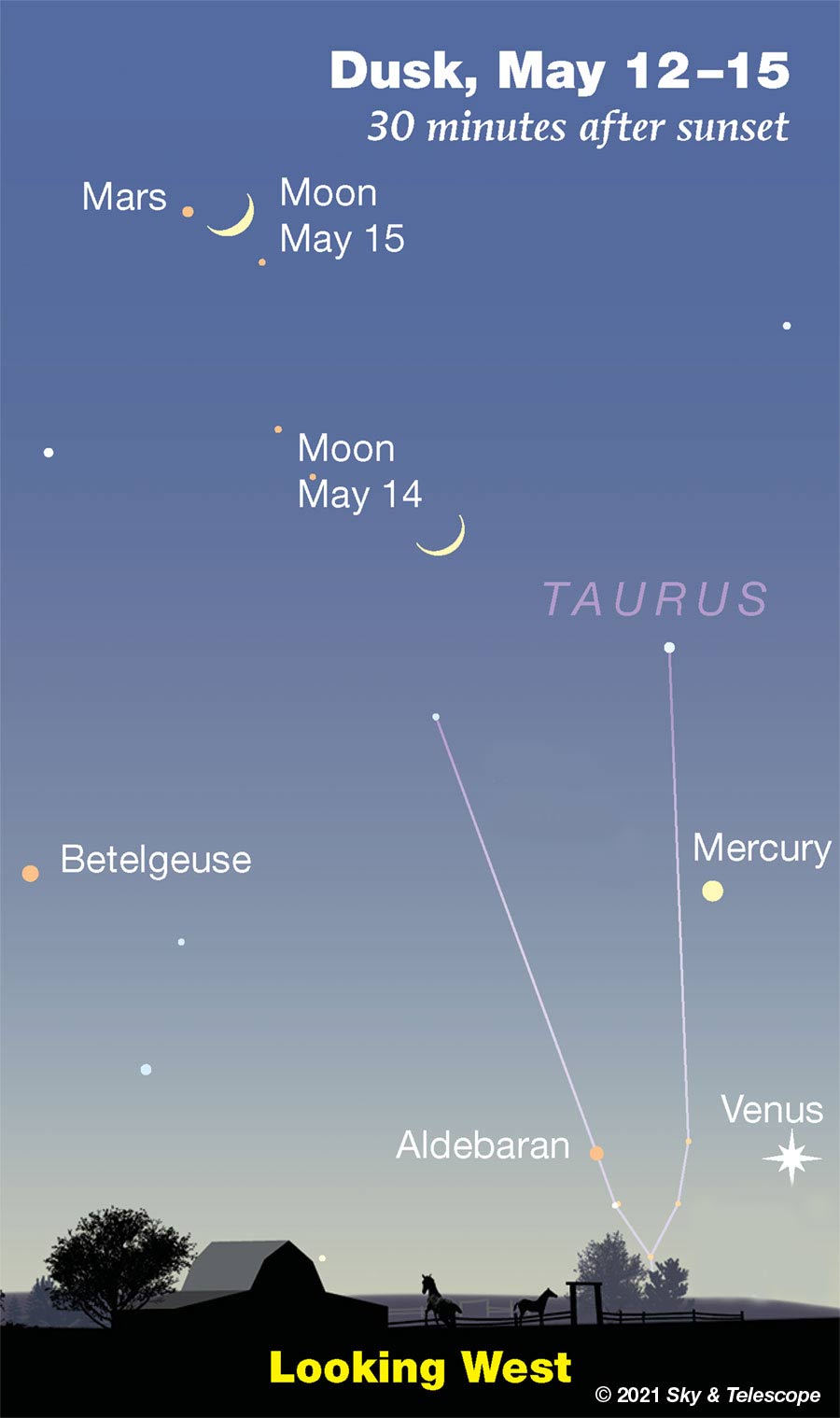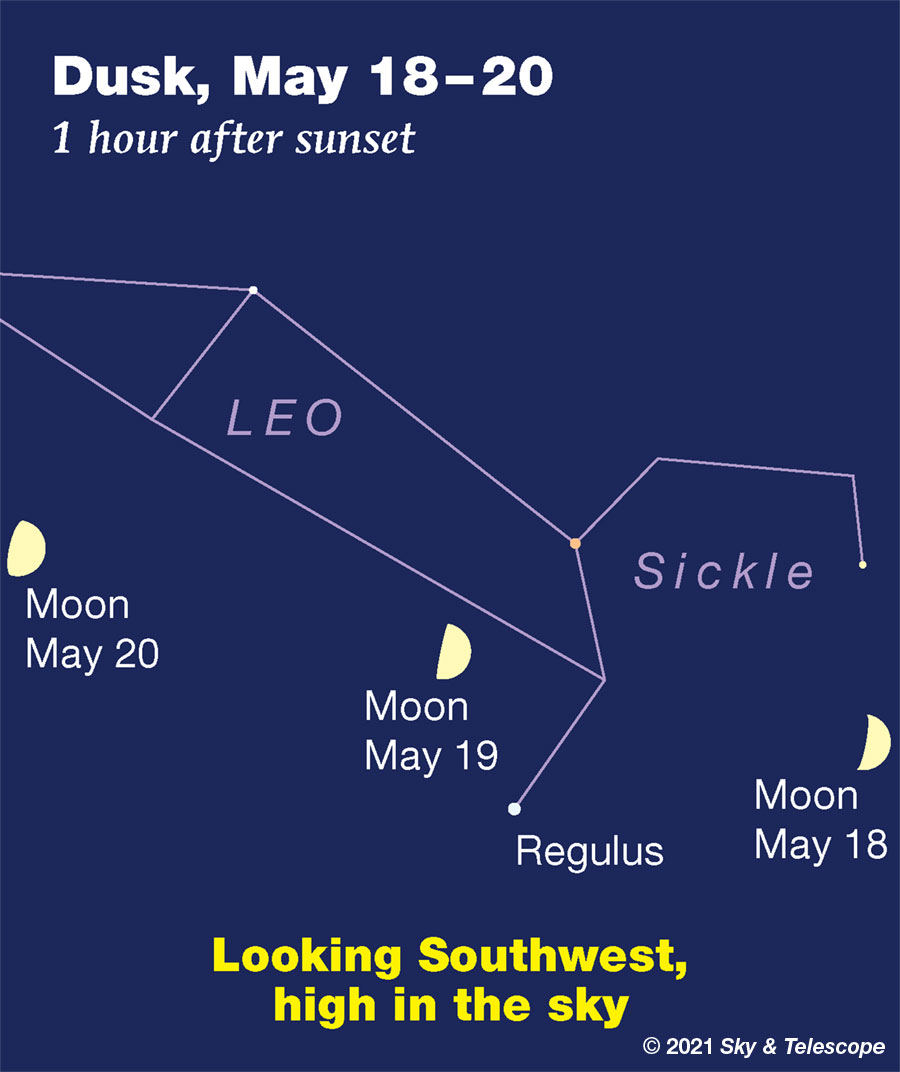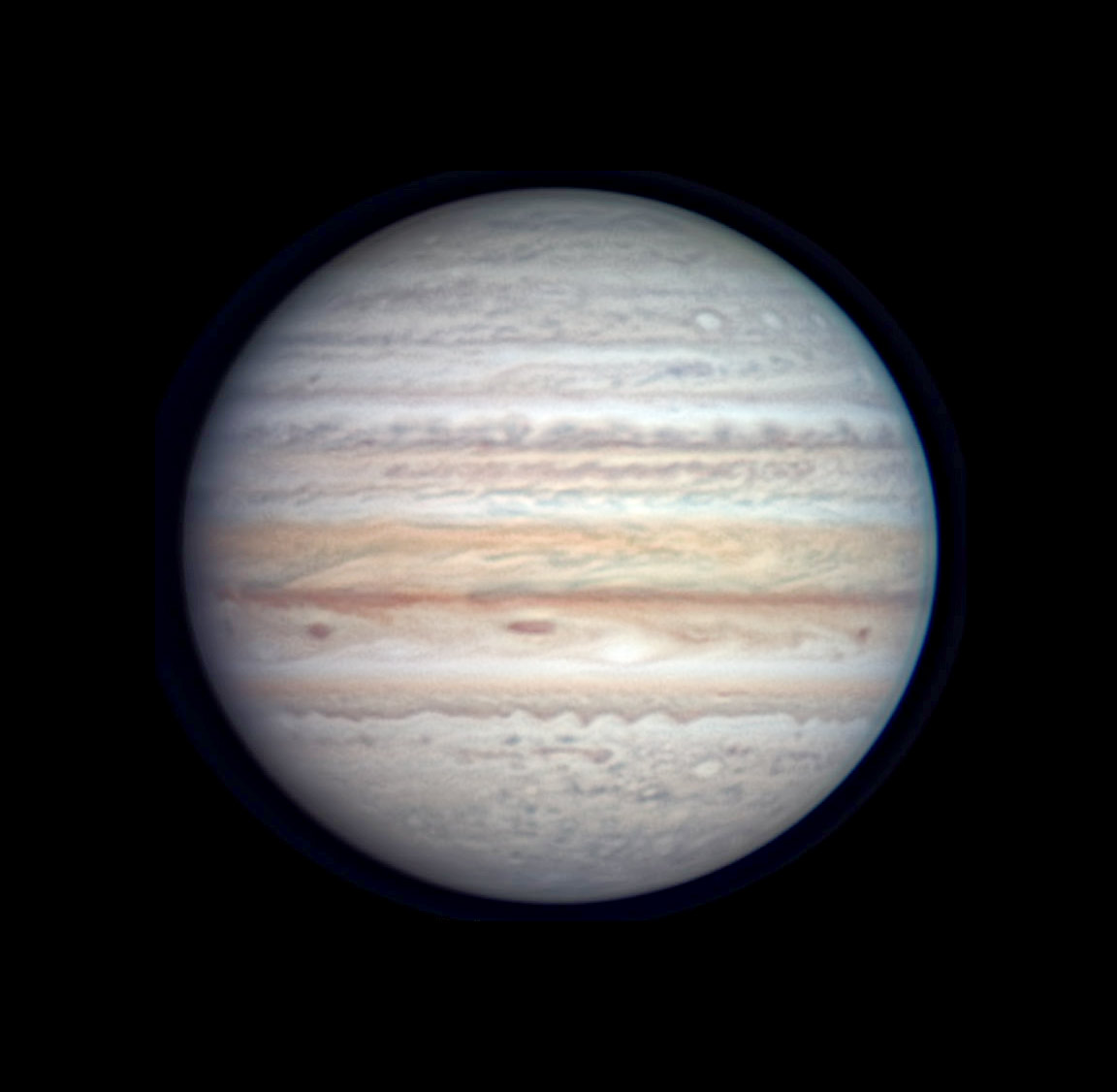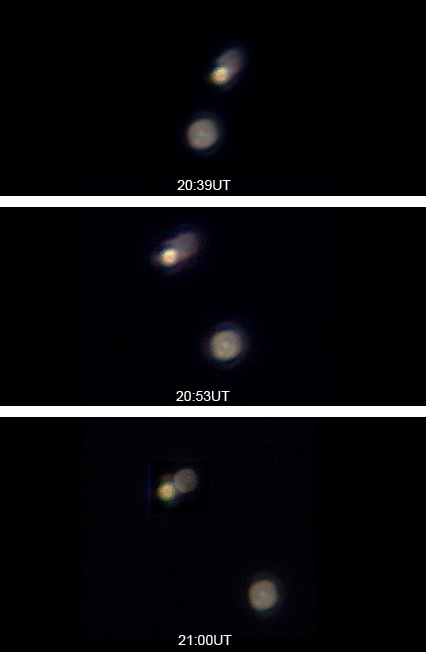Nova Cassiopeiae 2021 shot up to magnitude 5.4 around May 8th — making it faintly visible to the naked eye in a dark sky — eight weeks after its initial outburst to magnitude 7.5. It had remained 7th or 8th mag all during the interim. See Nova in Cassiopeia Brightens Suddenly, with finder charts and comparison stars.
UPDATE MAY 19: And after about five days it faded back almost as fast as it rose. As of late on May 19th UT it was down to magnitude 7.5. Spectral details.
The nova is low in the north in the evening but high in the northeast before the first beginnings of dawn. Set your alarm to go look at least two hours before your local sunrise time.
FRIDAY, MAY 14
■ This week, find Mercury and Venus low in the west-northwest in twilight. The first of them you may spot is Venus, bright at magnitude –3.9, very low exactly west-northwest. As the sky darkens, Mercury will come into view about 8° above Venus as shown below. Mercury keeps fading this week, from magnitude +0.2 to +1.0. Meanwhile, little Mars remains to their upper left. And this evening, the crescent Moon hangs in between.

SATURDAY, MAY 15
■ Now the crescent Moon shines with faint, distant Mars, as shown above. Mars is nearly on the opposite side of its orbit from us, 18 light-minutes away compared to the Moon's 1.3 light-seconds.
■ Summer is still five weeks off, but the Summer Triangle is making its appearance in the east, one star after another.
Its first star in view is bright Vega, in the northeast as twilight fades. Next is Deneb, lower left of Vega by a little more than two fists at arm's length. The third corner of the triangle is Altair. It rises in the east, far to the lower right of Vega and Altair, around 11 p.m.
SUNDAY, MAY 16
■ Meanwhile, Arcturus is the brightest star very high in the east. Spica shines lower right of it by about three fists at arm's length. Look to the right of Spica by half that distance for the distinctive four-star constellation of Corvus, the springtime Crow.
More on Arcturus? See the June Sky & Telescope, page 45, for the "many distinctions" of this star.
MONDAY, MAY 17
■ What is the oldest thing you have ever seen? For everyone in the world it's at least the Sun and other objects of the solar system, age 4.6 billion years. Everything on or near Earth's surface is much younger.
Next is Arcturus, which most people have surely seen whether they knew it or not, since it's one of the brightest stars in the sky. It's a Population II orange giant, age about 7 billion years, just passing through our region of the Milky Way.
Amateur astronomers have globular clusters. Most are older still, at least in part. White dwarfs in the familiar M4 in Scorpius have been dated at 12.7 ±0.7 billion years.
But individual stars that you can observe? For that you want Bob King's new article In Search of Ancient Suns, with finder charts. Assigning dates to individual stars from the first eras after the Big Bang is still iffy; astronomers have to work from the near-absence of heavy elements in their spectra. But a relatively nearby 6th-magnitude star in Bootes and a 7th-magnitude star in Libra, both in binocular range, await you these May and June evenings. They probably date from, respectively, about 12½ billion and at least 13 billion years ago. These will probably be the oldest things you have ever seen, or will. The Big Bang itself is well dated at 13.8 billion years.
One could pick nits. Pick a proton, any proton right in front of you, and it has very likely remained intact since the Big Bang's first millionth of a second. What a variegated history it has seen since then!
TUESDAY, MAY 18
■ This evening the Moon hangs in western Leo, below the front of the Sickle as shown below.
As soon as night is fully dark, look almost two fists at arm's length below the Moon for the dim head of Hydra.

WEDNESDAY, MAY 19
■ First-quarter Moon (exactly so at 3:13 p.m. EDT). This evening it shines over Regulus, as shown above.
THURSDAY, MAY 20
■ The gibbous Moon a day or two past first quarter is, I think, my favorite phase to observe. The terminator crosses all kinds of rich yet familiar lunar territory, and the Moon is highest in the convenient evening hours.
Did you know there are seven classical crater types? Before the space age, these categories spanned everything from the largest "walled plains" to the tiniest telescopic "crater pits." This stepwise classification reigned from 1837 until 1960, when space science was turning more serious and the impact theory of crater origins finally displaced the widely assumed volcanism of previous generations.
But the old descriptors still work for telescopic observers. Explore them, with examples, using the article in the June Sky & Telescope, page 52.
FRIDAY, MAY 21
■ Vega is now nicely up in the east-northeast after dark. Look for its faint little constellation Lyra, the Lyre, dangling down from it with its bottom canted to the right. Lyra's main stars form a little equilateral triangle (Vega is one corner) and a parallelogram attached to the triangle's bottom star.
SATURDAY, MAY 22
■ Vega is the brightest star in the east-northeast after dark. Look upper left of it by 14° (about a fist and a half at arm's length) for Eltanin, the 2nd-magnitude nose of Draco the Dragon. Closer above and upper left of Eltanin are the three fainter stars forming the rest of Draco's stick-figure head, also called the Lozenge. Draco always points his nose to Vega, no matter how he's oriented. He seems curious about it. Do dragons eat jewels? He has made no move on it yet.
The faintest star of Draco's head, opposite Eltanin, is Nu Draconis. It's a fine, equal-brightness double star for binoculars (separation 61 arcseconds, both magnitude 4.9). The pair is 99 light-years away. Both are hot, chemically peculiar type-Am stars somewhat larger, hotter, and more massive than the Sun.
This Week's Planet Roundup
Mercury and Venus come into view in the west-northwest in the afterglow of sunset. You may first spot Venus, bright at magnitude –3.9, very low. Look about 30 or 40 minutes after sundown to catch it before it sets.
As the sky darkens further, Mercury comes into view about 8° above or upper left of Venus. Mercury is getting fainter; it fades from magnitude +0.2 to +1.0 this week.
Mars (magnitude +1.7, in lower Gemini) glows in the west-northwest right after dark. It's less than halfway from Procyon (left of it) to Capella (farther right of it). In a telescope Mars is a mere 4.4 arcseconds wide: just a tiny, shimmering blob.
Jupiter and Saturn (in dim Aquarius and Capricornus, respectively) are well up in the southeast before the first light of dawn. Jupiter grabs attention at magnitude –2.3. Saturn, 17° to Jupiter's right, is one sixteenth as bright at magnitude +0.7.


We're in a season of such mutual eclipses of Jupiter's moons; see predictions for this month in the May Sky & Telescope, page 50. Will you be lucky enough to have one occur while Jupiter is in its brief pre-dawn view from your location? Don't expect your scope to resolve Jupiter's moons into disks like this visually!
Uranus is hidden in the glow of dawn.
Neptune is still low in the east as dawn begins.
All descriptions that relate to your horizon — including the words up, down, right, and left — are written for the world's mid-northern latitudes. Descriptions that also depend on longitude (mainly Moon positions) are for North America.
Eastern Daylight Time, EDT, is Universal Time minus 4 hours. Universal Time is also known as UT, UTC, GMT, or Z time. To become more expert about time systems than 99% of the people you'll ever meet, see our compact article Time and the Amateur Astronomer.
Want to become a better astronomer? Learn your way around the constellations. They're the key to locating everything fainter and deeper to hunt with binoculars or a telescope.
This is an outdoor nature hobby. For an easy-to-use constellation guide covering the whole evening sky, use the big monthly map in the center of each issue of Sky & Telescope, the essential magazine of astronomy.
Once you get a telescope, to put it to good use you'll need a detailed, large-scale sky atlas (set of charts). The basic standard is the Pocket Sky Atlas (in either the original or Jumbo Edition), which shows stars to magnitude 7.6.

Next up is the larger and deeper Sky Atlas 2000.0, plotting stars to magnitude 8.5; nearly three times as many. The next up, once you know your way around, are the even larger Interstellarum atlas (stars to magnitude 9.5) or Uranometria 2000.0 (stars to magnitude 9.75). And be sure to read how to use sky charts with a telescope.
You'll also want a good deep-sky guidebook, such as Sky Atlas 2000.0 Companion by Strong and Sinnott, or the bigger (and illustrated) Night Sky Observer's Guide by Kepple and Sanner.
Can a computerized telescope replace charts? Not for beginners, I don't think, and not on mounts and tripods that are less than top-quality mechanically, meaning heavy and expensive. And as Terence Dickinson and Alan Dyer say in their Backyard Astronomer's Guide, "A full appreciation of the universe cannot come without developing the skills to find things in the sky and understanding how the sky works. This knowledge comes only by spending time under the stars with star maps in hand."
![]() Audio sky tour. Out under the evening sky with your
Audio sky tour. Out under the evening sky with your
earbuds in place, listen to Kelly Beatty's monthly
podcast tour of the heavens above. It's free.
"The dangers of not thinking clearly are much greater now than ever before. It's not that there's something new in our way of thinking, it's that credulous and confused thinking can be much more lethal in ways it was never before."
— Carl Sagan, 1996
"Facts are stubborn things."
— John Adams, 1770
 7
7









Comments
mary beth
May 14, 2021 at 3:06 pm
Summer stargazing is so so fun! Loving Spica, I always feel like it is such an announcer of summer and upcoming Scorpius constellation, my very favorite!
@ ErnieOstuno.... glad you got to enjoy Venus and the baby moon. It was cloudy here in Houston where I live so I did not get to see it but good to hear you are having nice weather up north!
Monday, May 17: And God said, “Let there be light”; and there was light. Genesis 1:3 RSV
You must be logged in to post a comment.
Yaron Sheffer
May 15, 2021 at 9:43 am
Nit picking cont'd 😉 Kinda hard to either see or catch protons. Although astronauts have seen cosmic rays hitting their eyeballs, me think, and those are mostly protons. Our next best candidates are the electrons: we see them EVERYWHERE. They date from the last millionth of the first second after the big bang... when protons were about to celebrate their 1,000,000th birthperiod.
You must be logged in to post a comment.
Rod
May 15, 2021 at 12:25 pm
mary beth, Yaron Sheffer, glad you folks are getting out under the stars. Lately I spend more time weed whacking and pasture mowing 🙂 Interesting physics explaining the origin of electrons and protons and their masses, 1E-6 s^-1 after BB 🙂 Consider Planck time, Planck length, inflation period (perhaps 1E-36 s^-1 after BB, post-inflation period, etc.) There are many constants and masses that can form all wrong 🙂 Just think what the universe would look like if the electron and proton mass decayed quickly in just seconds or the cosmological constant bounced all over too. Wrong values here in GR make for space expanding so fast you and I could not see the Moon today, and we would not be here either 🙂
You must be logged in to post a comment.
mary beth
May 15, 2021 at 4:06 pm
I think Quark and Gluon would be great names for characters the next Disney ‘Frozen’ movie series.....
You must be logged in to post a comment.
Rod
May 15, 2021 at 9:24 pm
mary beth et al. After some more weed whacking this afternoon, I did enjoy some time out viewing the waxing crescent Moon tonight. Easy viewing after whacking all those weeds 🙂 From my stargazing log: Observed 1915-2030 EDT/2315 UT - 0030 UT. Sunset 2012 EDT. Moon set 2359 EDT/0359 UT. First Quarter Moon 19-May-2021 1913 UT. Relaxing evening views of the waxing crescent Moon tonight in Gemini. At 71x the telescope resolved features on the Moon ~ 8 km diameter or 4.2 arcsecond given the Moon's distance tonight. True FOV ~ 60.48 arcminute angular size, Moon's angular size ~ 30.11 arcminute. Good views of craters and details after 2000 EDT approaching sunset and shortly after sunset. Hercules, Atlas easy to see. Small craters like Greaves in Mare Crisium easy to see. While viewing the Moon, a party balloon floated by the FOV high up with colors, undulating in the winds aloft. NWS EMI winds aloft at 9,000, 220/05 knots.
You must be logged in to post a comment.
New Jersey Eclipse Fan
May 16, 2021 at 1:32 am
Thanks to everyone for your entries! Here's mine: "Rod's" crescent moon accompanied me during my drive on the NJ Turnpike back home from NYC. As I drove south alone, it was constantly viewable out the passenger side window to the west, of course. As it slowly set, it was swallowed up by clouds on the dark horizon before I reached my destination. But it was nice to have "company" for most of the hour-long trip.
You must be logged in to post a comment.
mary beth
May 16, 2021 at 12:03 pm
Hi New Jersey Eclipse Fan! Love your story about your wingman, the nan in the moon! Hope you had a nice trip entirely!
You must be logged in to post a comment.
You must be logged in to post a comment.